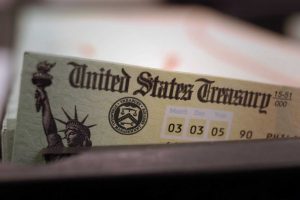What the federal debt ceiling showdown could mean for you

- Congress must suspend or raise the debt ceiling or the country runs the risk of default.
- If lawmakers can’t reach a deal, it will increase borrowing costs, delay Social Security checks and veteran benefits and disrupt financial markets across the board.
The clock is ticking on the federal debt ceiling.
Lawmakers have until the end of this month to raise the debt limit once again. In a Wall Street Journal op-ed Sunday, Treasury Secretary Janet Yellen said failing to act could spark an economic catastrophe.
While the legal cap on how much the U.S. can borrow doesn't impact what consumers can spend, if Congress can't reach a deal on a new debt limit before October, it will put a stranglehold on everything from government payments to the ability to borrow, she cautioned.
"In a matter of days, millions of Americans could be strapped for cash," Yellen said.
"Nearly 50 million seniors could stop receiving Social Security checks for a time. Troops could go unpaid. Millions of families who rely on the monthly child tax credit could see delays."
Why federal borrowing limit keeps coming up
The federal debt is the amount of money the government currently owes for spending on payments such as Social Security, Medicare, military salaries and tax refunds.
The debt limit allows the government to finance those existing obligations.
"Raising the debt ceiling doesn't authorize additional spending of taxpayer dollars. Instead, when we raise the debt ceiling, we're effectively agreeing to raise the country's credit card balance," Yellen said.
Congress and the White House have changed the debt ceiling almost 100 times since the end of World War II, according to the Committee for a Responsible Federal Budget. In the 1980s, the debt ceiling increased to nearly $3 trillion from less than $1 trillion. During the 1990s, it doubled to nearly $6 trillion, and doubled again in the 2000s to over $12 trillion.
In 2019, Congress voted to suspend the debt limit until July 31, 2021. Now, the Treasury is using temporary "emergency measures" to buy more time so the government can keep paying its obligations to bondholders, veterans and Social Security recipients.
But once the government exhausts those measures, it will no longer be able to issue debt and could run out of cash-on-hand.
More from Personal Finance:
Here's how to prioritize your financial goals
Here are some tips for beating inflation as prices start to rise
Impulse spending is an issue for many consumers
Of course, the U.S. government has never actually defaulted on its debt and isn't expected to this time, either. Yet, the threat of defaulting has come up many times. And even that has its consequences.
Some economists had hoped Senate Democrats would include a debt ceiling increase as part of the $3.5 trillion spending plan.
However, the budget resolution left out the ceiling entirely, and the government will be near the brink of default just as Republicans and Democrats face off over how much is too much federal spending.
"It's a financial game of chicken," said Mark Hamrick, senior economic analyst at Bankrate.com.
Why just the threat of default has consequences
In the worst-case scenario, the federal government would default, at least temporarily, on some of its obligations, including those Social Security payments, veterans' benefits and salaries for federal workers.
In addition, potential downgrades of U.S. credit ratings would hammer Treasurys. Demand for U.S. Treasury bonds could sink if they are no longer considered a reliable, safe-haven investment and bondholders would demand dramatically higher interest rates to compensate for the increased risk.
That, in turn, would send other borrowing costs higher, including credit cards, car loans and mortgage rates (which generally are pegged to yields on U.S. Treasury notes).
At the very least, fear of default could rattle the stock market and send shock waves throughout the economy, according to Bankrate's Hamrick.
"If you go back to a decade ago, there was an immediate selloff in the financial markets — it hit investors hard and runs the risk of a cascading financial crisis," he said.
In 2011, a debt limit standoff in Congress brought the country very close to a default before lawmakers finally struck a deal, but not without a downgrade of the country's credit rating and significant market volatility.
Between July and October of that year the S&P 500 sank more than 18%.
This time, lenders may start tightening their standards in advance to reduce their exposure — or risk — during what could be a contentious battle, said Yiming Ma, an assistant finance professor at Columbia University Business School.
"No one thinks it's going to be a straight default but even just the uncertainty can impact borrowing terms and borrowing availability," she said.
"If I was someone about to take out a loan, I would look at the terms now," Ma added. "In the last days, there could be a frenzy going on."
"We have learned from past debt limit impasses that waiting until the last minute to suspend or increase the debt limit can cause serious harm to business and consumer confidence, raise short-term borrowing costs for taxpayers, and negatively impact the credit rating of the United States," Yellen also wrote in a letter to House Speaker Nancy Pelosi earlier this month.
Subscribe to CNBC on YouTube.
Source: Read Full Article
